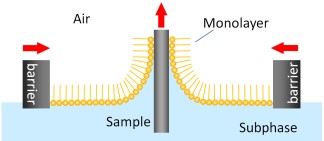Analysis of Atomic or Molecular Monolayers
Monolayers are thin individual layers consisting of atoms, molecules or cells on a surface. Due to their special properties, monolayers are of great interest in almost all high-tech areas.
In the semiconductor industry, layers consisting of a few atomic monolayers are already used for the production of fast switching transistors. The downsizing of transistor structures predicted by Moore's law requires a further approximation to the deposition of atomically sharp monolayers in the coming years. Therefore, processes such as chemical vapor deposition (CVD) and atomic layer deposition (ALD) are being intensively researched and developed to be able to deposit high-quality, atomic monolayers with a thickness of approx. 0.3 nm per layer in the future.
Molecular monolayer layers are also of great interest. These monolayers can be produced from thiol or silane solutions using self-assembling monolayers (SAM) and are already in use today as long-lasting tarnish protection for precious metal surfaces or for the functionalization of electrodes in the field of sensors or nanoelectronics. In addition to the self-organizing deposition of monolayers, highly ordered, molecular monolayers can also be produced using the Langmuir-Blodgett technique (LB technique). With the help of a so-called film balance, an ordered amphiphatic molecular layer is generated and transferred to a suitable solid substrate. The molecular films produced in this way are used, among others, as anti-reflective layers, in the production of organic semiconductor elements, as a component of biosensors and as models for biological membranes.
In the Tascon laboratories we have a variety of analytical methods for the analysis of monolayers. For example, we use LEIS analysis to determine the closeness and average layer thickness of layers manufactured by Atomic Layer Deposition (ALD layers). SEM analysis can be used to check the order of organic monolayers (packing density, domain formation, ...). The ToF-SIMS method serves to identify the molecules used in a molecular monolayer. It can also be used as temperature-programmed SIMS (TP-SIMS) to assess the average binding energy of an organic, covalently bound monolayer to the surface. ToF-SIMS analyses can also be applied to image the lateral distribution of organic monolayers on a surface, as the following example shows:

Organic monolayers
Model system for biological membranes
The Langmuir-Blodgett technique (LB technique) was used to obtain a biological model membrane on a glass substrate from two lipids and an amphiphatic protein using LB transfer. The lipid-protein interactions were examined more closely using the immobilized membrane monolayer. For this purpose, the chemical composition of the LB film was analyzed in our laboratory using ToF-SIMS analyses. Contrary to the expectations of the biochemists involved, an opposing distribution of lipid I (dDPPG) and the protein SP-B was demonstrated in these studies. Further information on the example shown can be found in the associated publication.
| Lipid 1 (dDPPG) |  |
 |
| Lipid 2 (DPPC) |  |
|
| Protein (SP-B) |  |
An example for the analysis of organic multilayer systems can be found here.
Tascon - your partner for the analysis of atomic and molecular monolayers
Are you also interested in analyses of your own atomic or molecular monolayers? Do not hesitate to contact us. The Tascon team looks forward to your inquiry!
Get in touch. Contact one of our analytical professionals:
(845)-352-1220

